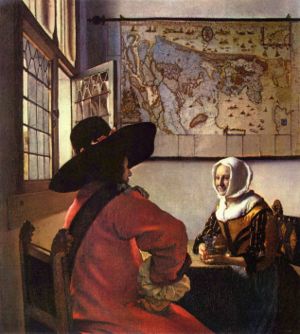July 29, 2008
Gratuitous Art Posting

Officer And A Laughing Girl, 1657
This is the kind of thing I absolutely adore: In the Literary Review, Lisa Jardine reviews Timonthy Brook's new book, Vermeer's Hat - The Seventeenth Century and the Dawn of the Global World. An excerpt:
On the cover of Timothy Brook's enthralling new book is a well-known painting by Jan Vermeer of a laughing young woman in yellow, seated at a table and bathed in sunlight which floods through a half-open window. Her hands cup a crystal glass, and she is flirting with a dashing officer in a red coat seated opposite her. He has his back towards us, his right arm akimbo, but the composition is dominated by the outsized, black beaver hat he wears, fashionably trimmed with ribbon. This hat, and the diamond-paned window against which it is framed, set the stage for Vermeer's Hat. The minutely observed and meticulously executed details in Vermeer's paintings, Brook suggests, offer us metaphorical 'doors' - apertures opening up, like that half-open window, towards a wider world. Such doors, proposes Brook, take us directly into the rapidly expanding seventeenth-century world of global exploration and trade. Objects interjected into Vermeer's compositions draw the reader's eye and mind towards vistas beyond the sitters in their quintessentially Dutch surroundings.In the case of the painting I have just described, that lovingly textured broad-brimmed hat opens a door which leads from Vermeer's Delft westwards across the Atlantic Ocean to Canada, where buccaneering adventurers like Samuel de Champlain - leader of a French mission seeking a northwest passage through the Great Lakes to the Pacific in the 1600s - exchanged beaver pelts for firearms with the Huron chiefs to finance their journeys. Back in Europe, the underfur of those much-sought-after pelts was stewed in copper acetate and mercury-laced glue to make the very best felt for the most fashionable hats.
Champlain's ultimate goal was not North America but China. In the early seventeenth century, all navigable routes led to the apparently boundless commercial opportunities offered by the Orient. What makes Vermeer's Hat such an original and stimulating book, however, is not simply the way that Brook traces threads from materially acquisitive Europe to more aloof markets in the East. He is a distinguished professor of Chinese studies, and each freshly painted door he opens to reveal connections between China and the Netherlands tells us as much about China as it does about ourselves. The story of tobacco, for example, tells us as much about the route tobacco took from Mexico to Manila, and thence to China, as it does about its arrival in Europe. By explaining the way in which the stories differ - tobacco caught the imagination of European working people, whereas in China smoking was an elite pursuit - Brook deftly expands the reader's understanding of some of the motives behind China's self-imposed isolation, as well as giving us some of the same sort of captivating local detail more familiar to us from the Dutch milieu.
Granted that the subject here is painting, but if I may violently switch metaphors, History is a fugue of constantly interweaving, interrelating and interreactive themes. And I never tire of studying the ways in which its disparate parts come together. Here, that pleasure is compounded, of course, by the visual delight of examining Vermeer's work. Think I haven't already dashed over to the Devil's Website to pick up a copy of this book? Ha, ha - think again!
Yips! to Arts & Letters Daily.
Posted by Robert at July 29, 2008 08:54 AM | TrackBack

 Image courtesy of the lovely and talented
Image courtesy of the lovely and talented 